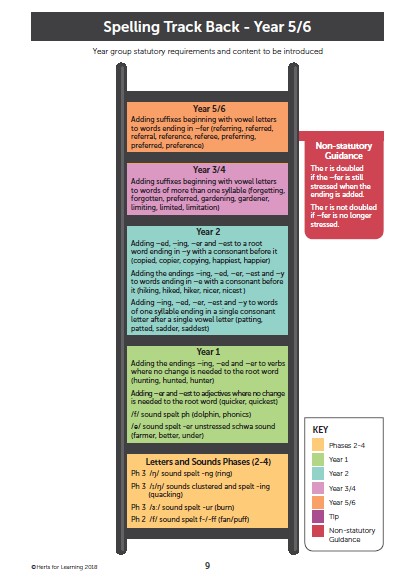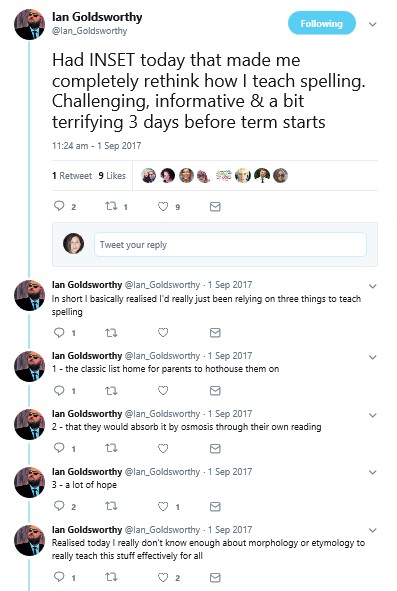
What’s the issue?
In 2014, the National Curriculum catapulted spelling at KS2 into the limelight. The 2016 KS2 interim assessment framework document further intensified the focus on spelling, as children could not be judged as ‘working at the expected standard’ if they had not first demonstrated that they could spell most words correctly from the years 3/4, and then from the years 5/6 programme of study. The ‘spelling geek’ inside me was quietly thrilled as were many of the teachers and colleagues I work with. Not because of the prescriptive way it had been ‘forced’ upon us by a strict secure fit model (ITAF), more that finally, spelling wasn’t having to play second fiddle to other aspects of writing. There was an overwhelming feeling that something more had to be done about spelling, and not just at Year 6, but throughout KS2.
My colleague, Penny Slater, had previously stated in a blog that the side-lining of spelling had ‘led to a skewed perception of spelling as an add-on to the process of becoming literate, rather than an integral part of it’. This statement really rang true with me, and seemed to be a message that I too had been led to believe during the early stages of my teaching career.
I know not everyone celebrated this ‘catapulting’ in the same way I did, and I completely understand reservations, or preferences towards a more creative and flexible approach to writing and composition that takes into consideration a child’s particular strengths and weaknesses. However, in my experience, the more fluent a child becomes in spelling (and handwriting) the more they are cognitively freed up to focus on the composition, so to my mind it’s a win either way.
A whole school approach
It was during this period I started working on a project with the English Subject Leader and staff at Oakmere Primary School, in Potters Bar, Hertfordshire. The number of children achieving the EXS standard had increased in writing by 24% from 2016 to 2017 to 70% However, monitoring including book scrutinies, and discussions with teachers still identified the teaching and application of spelling in writing as a key development priority across KS2. The school and Subject Leader were keen to raise standards and try something new. We agreed to focus specifically on plugging gaps for pupils that were struggling, and focus on how to manage teaching ARE, whilst still meeting the needs of pupils who were struggling with spelling.
I delivered an INSET at the beginning of this academic year. During the INSET, the teachers buddied up and had a detailed look at the spelling of a group of low-attaining pupils in their class. They analysed the spelling errors for those pupils and then used this to identify key areas to prioritise in teaching. A spelling track back document was then used to see which year group misconceptions had stemmed from; consideration was given to how to build on the ‘last good’ bit of learning and how to link their pupils’ gaps to their year group expectations whilst teaching the whole class.
Once the gaps for the children had been identified, teachers began grappling with a slightly different way of planning and delivering the teaching of spelling.
See below an example of the Steps to Spelling document which can used to:
- track back and identify where any misconceptions or gaps in learning may be present;
- differentiate for pupils who need to accelerate to age-related expectations;
- support teachers in securing their subject knowledge.

The Steps to Spelling and Essential Spelling resources are now available from the HFL Education shop.
Just a couple of days after the INSET, one of the teachers tweeted the following reflection:

I could not have summed it up better myself. In his reflections, I think his tweet really hit the nail on the head. In the past, I too, had used these methods (including hope), and oddly for some of my pupils this had actually worked. However, to really make a significant difference to children’s learning we have to have deep knowledge of the areas we are teaching: ‘hope’ is no longer good enough.
The Sutton Trust review acknowledges the importance of teachers having very secure, deep subject knowledge if they want to support children in tackling tricky concepts:
When teachers’ knowledge falls below a certain level it is a significant impediment to students’ learning. As well as a strong understanding of the material being taught, teachers must also understand the ways students think about the content, be able to evaluate the thinking behind students’ own methods, and identify students’ common misconceptions. (Coe R, Aloisi C, Higgins S and Major L.E. What makes great teaching? Review of the underpinning research. October 2014)
To summarise the approach taken by the case-study school:
- develop teachers’ subject knowledge in order for them to identify misconceptions accurately;
- complete a gap analysis of pupils’ spelling errors in their independent writing;
- prioritise key learning areas to focus on from the analysis;
- use the analysis to track back to where the pupils are working from;
- use the track back information to teach from and build on the last ‘good’ bit of learning.
Five months on at Oakmere, many parents from the Year 2 class have reported that they have noticed an improvement in their child's spelling ability and confidence to spell, and the class teacher has commented that it appears to be having a good impact on the pupils’ writing. In Years 4 and 5, they have now established a really effective sequence of assessing: teaching in differentiated groups based on the tracking back that feeds in to the initial sound/spelling statement and a final assessment to track progress. In Year 6, some children have made progress, but there still seems to be a group who have been frustratingly resistant to making progress. The class teacher feels this may be due to individual factors that influence the effectiveness of their learning. I will be considering these pupils and possible next steps in the second part of this blog.
I can’t pretend that for many children the way we have always taught spelling and still do (for some) hasn’t worked, because it has. It just doesn’t work for all of the children all of the time, and if what you’re doing isn’t working, then you’re just going to have to try something else. If you are looking for that ‘something else’, then the approach used at Oakmere School might be worth a try.
With thanks to Oakmere School, Potters Bar, Herts.
Blog written by Sabrina Wright.


